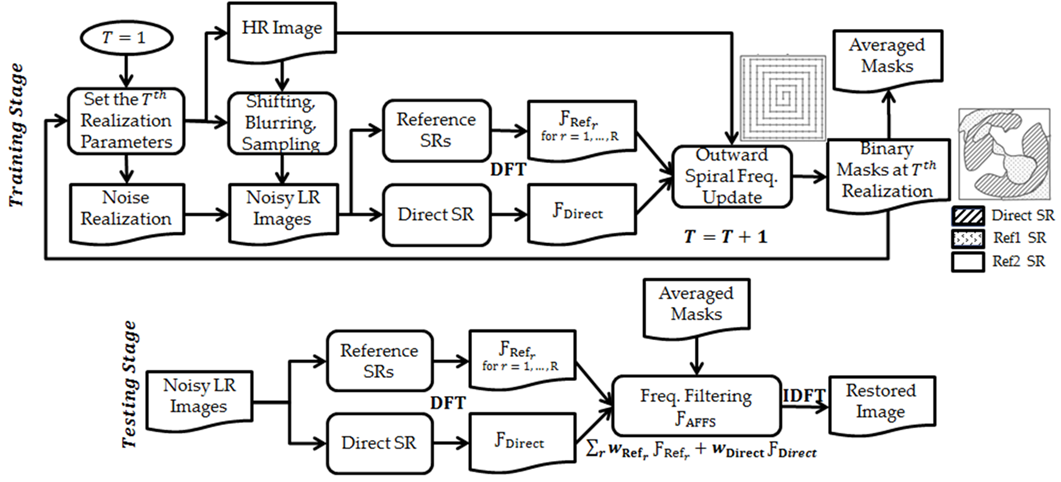
Department of Electrical & Computer Engineering
Signal and Image Laboratory (SaIL)
The University of Arizona®
|
|
|
|
Past Research |
Direct Superresolution Technique for Realistic Image
Reconstruction
Student: Basel Salahieh
| |
Traditional superresolution (SR) techniques employ optimizers, priors, and regularizers to deliver stable, appealing restorations even though deviating from the real, ground-truth scene. A non-regularized direct SR technique, illustrated in Fig. 1, has been developed to uniquely solve a set of linear equations representing the multi-shift image reconstruction problem with sufficient measurements to deliver realistic reconstructions without any inherent bias imposed by improper assumptions in the inverse problem.

Figure 1: The multi-shift LR measurements (top-left) and steps (bottom-left) summarizing the direct SR technique. A sample of low-resolution (LR) images and the direct SR's reconstruction results at 4× subsampling factor under ideal imaging conditions are shown for USAF target (top-right) and cameraman image (bottom-right).
An adaptive frequency-based filtering scheme (AFFS), shown in Fig. 2, is introduced to gain robustness against poor focus, misestimated shift, boundary variations, and noisy scenarios while maintaining the merit of direct SR to achieve optimal restorations with minimal artifacts.

Figure 2: Block diagram illustrating the adaptive frequency-based filtering scheme in the training stage (top) and the testing stage (bottom).
Simulation results, presented in Fig. 3, demonstrate that more fine features can be resolved with the developed technique as compared with other SR techniques such as bicubic SR and multi-channel blind deconvolution (MCBD) SR. Simulations also show that the retrieved high-resolution features are successfully transferred by the AFFS to produce an artifact-suppressed high-resolution image under realistic imaging conditions such as noisy environment, blurring capturing, boundary tolerance, and shift misestimate.

Figure 3: Visual comparison of various SR techniques sorted row-wise at 2X subsampling factors under various realistic imaging conditions sorted column-wise using sensor shift model, noiseless environment (NS = 0.1%), in-focus measurements (σblur = 0.75 pixel), matched boundary conditions (BTol = 10%), and known non-integer-pixel shifts (STol = 0.1%) unless mentioned differently in each column. The associated numerical error RMSE% is shown at their left.
This work was a collaborative effort with Prof. Rongguang Liang in the
College of Optical Sciences, University of Arizona.
Publications:
-
Basel Salahieh, Jeffrey J. Rodriguez, and Rongguang Liang, "Direct Superresolution for Realistic Image Reconstruction," Optics Express, vol. 23, no. 20, Oct. 2015, pp. 26124-26138. [ PDF ]
-
Basel Salahieh, Jeffrey J. Rodriguez, and Rongguang Liang, "Direct Superresolution Technique for Solving a Miniature Multi-Shift Imaging System," Imaging and Applied Optics 2015, OSA Technical Digest, Optical Society of America (OSA), 2015, paper JW3A.5, 3pgs. Presented at Computational Optical Sensing and Imaging (COSI), Arlington, VA, June 7-11, 2015. [ PDF ]
|
|
1230 E. Speedway Blvd., P.O. Box 210104, Tucson, AZ 85721-0104
|
©2014 All Rights Reserved. |
| Contact webmaster
|
|
|
|
|
